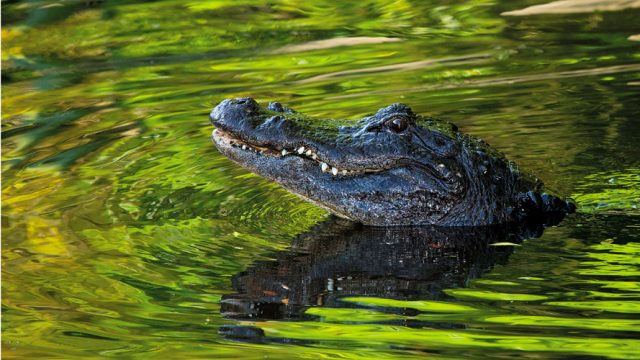Crocodile farming at Neyyar Wildlife Sanctuary
Most of us saw the late Steve Irwin and marvelled at how he handled a reptile so fearsome. What most of us probably don’t know is that a crocodile research centre in Kerala was once named after the Australian ‘Crocodile Hunter’. The Neyyar Wildlife Sanctuary, which spans around 12,000ha at the south-east corner of the Western Ghats, was declared a sanctuary in 1958. But serious conservation efforts started only in 1985 when a separate wildlife wing was established here. Today, it has a lion safari park, an elephant rehabilitation centre and deer rehabilitation centre. Also a crocodile farm, established in 1977 and renamed briefly the Steve Irwin Crocodile Rehabilitation and Research Centre, which has about 20 mugger crocodiles and provides information on their breeding and maintenance. The sanctuary is situated at the basin of the Neyyar River and encompasses the Agasthyarkoodam Peak (1,890m) and the Neyyar Dam Reservoir. The sanctuary also plays host to elephants, sloth bears, Nilgiri tahr, gaur, sambars, barking deer, Indian porcupines and Malabar squirrels. Cobras, vipers, pythons, rat snakes and flying snakes are commonly found. Avian visitors here include kingfishers, white-breasted water hen, little green heron, darters, brahminy kites, little egrets, etc. The lake formed by the dam across the Neyyar is a popular boating site. The nearest airport is Thiruvananthapuram (40km). The best time to visit is October to March.

Witness avian wonders at Thattekad Wildlife Sanctuary
The Thattekad Wildlife Sanctuary was given its status in 1983 at the recommendation of Dr Sálim Ali, the ornithologist who described it as the richest bird habitat in peninsular India, comparable only with the eastern Himalaya. It is also popularly called the Salim Ali Bird Sanctuary. Spanning over 25km along the north side of the Periyar River, it comprises tropical evergreen, semi-evergreen and deciduous forests. Thattekad literally means ‘flat forest’. It is home to as many as 500 species of exotic birds, including the ground thrush, large-billed leaf-warbler, Jerdon’s nightjar, whiskered tern, collared Scops owl, frogmouth, etc, and features 28 species of animals including leopard, sloth bear and porcupine. The nearest airport is Kochi (49km). Hornbill Camp (₹5,500; hornbillcamp. in) offers cottages outside the sanctuary. The best time to visit is October to March.

Spot the Nilgiri Tahr at Eravikulam National Park
Spread across 97 sq km in the Idukki district, Eravikulam National Park is rich in grasslands. Streams dissect the hills almost poetically and the wild flowers that grow here are any botanist’s dream. This national park is a wonderful site to study the biodiversity typical to a shola-grassland ecosystem. Shola in Tamil means ‘forest’, pockets of which are found scattered on these grasslands. The main attraction here though is the Nilgiri tahr, an endangered mountain goat. Tourists also come looking for Neelakurinji, a purple-blue shrub which blooms abundantly once in 12 years and drapes the Nilgiri hills in their trademark colour. Besides the Nilgiri tahr, the park is home to creatures like Nilgiri langur, Indian bison, leopard, etc. The nearest airport is at Kochi (21km), from where one can drive to Munnar, in turn connected with the park by a state road. The tourism zone starts from the Rajamallay checkpost and is open throughout the year except for a short period between January and March. More details at eravikulam.org.

Cat Tales at Idukki Wildlife Sanctuary
A boat ride on a placid blue lake with a delicious canopy of evergreen and deciduous trees enveloping it sounds too Amazonian to be true. But there’s rainforest here too—in the heart of Kerala, at the Idukki Wildlife Sanctuary. Situated between two rivers, Cheruthoni and Periyar, the sanctuary spans an area of 105 sq km at an altitude of 450-748m above sea level in the Thodupuzha and Udumpanchola talukas of the landlocked Idukki district. Adjacent to the Idukki Arch Dam, the sanctuary is home to a wide range of wildlife including jungle cats, tigers, elephants, bison, sambars, wild dogs, etc. Snakes too: cobra, viper and krait can be found rustling on the forest floor here. Birding enthusiasts can train their sights on the laughing thrush, Malabar grey hornbill, woodpeckers, bulbuls, flycatchers, etc in the area. Some parts of the sanctuary can be trekked, with permission from the forest department. Kottayam is the nearest railway station (114km); Madurai in neighbouring Tamil Nadu is around 140km away. Munnar (50km) offers a range of accommodation options.

Tribal Trails at Wayanad Wildlife Sanctuary
Man-animal conflict is increasingly common but most starkly so at the Wayanad Wildlife Sanctuary and its surrounding areas. Located in the Nilgiri Biosphere Reserve, the sanctuary is boxed in between the protected areas of Mudumalai, Tamil Nadu, and Nagarhole and Bandipur, Karnataka. The 345 sq km sanctuary comprises thick deciduous forests and is divided into two by plantations of eucalyptus and bamboo. The fauna that inhabits these forests includes elephants, gaur, deer, jungle cats, Indian civets, wild dogs, monitor lizards and the rarely sighted tigers and leopards. There are a total of 45 species of mammals, 203 species of birds and 30 species of amphibians here, besides 143 species of butterfly and 51 of dragonfly. The sanctuary is also home to tribal groups like Paniyas, Kurumas, Adiyars, Kurichyas, Ooralis and Kattunaikkans. In fact, there are over 90 human settlements around the sanctuary. Tigers and elephants are known to trespass into these settlements from the forest. Because of these tense dynamics, the tuskers of the region are also known to be more volatile in their behaviour. The nearest airport is at Kozhikode (125km to Sulthan Bathery). Accommodation at forest guesthouses is available inside the sanctuary (₹1,500; wayanadsanctuary.org) The sanctuary is closed from February 11 to April 10.




